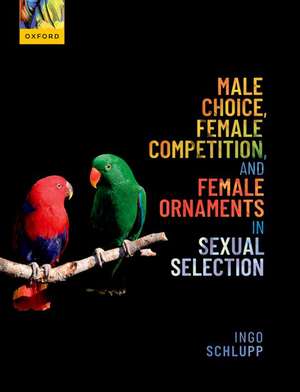Male Choice, Female Competition, and Female Ornaments in Sexual Selection
Autor Ingo Schluppen Limba Engleză Paperback – 20 ian 2023
| Toate formatele și edițiile | Preț | Express |
|---|---|---|
| Paperback (1) | 288.99 lei 10-16 zile | |
| OUP OXFORD – 20 ian 2023 | 288.99 lei 10-16 zile | |
| Hardback (1) | 456.51 lei 10-16 zile | |
| OUP OXFORD – 31 mai 2021 | 456.51 lei 10-16 zile |
Preț: 288.99 lei
Nou
Puncte Express: 433
Preț estimativ în valută:
55.30€ • 57.85$ • 45.94£
55.30€ • 57.85$ • 45.94£
Carte disponibilă
Livrare economică 01-07 martie
Preluare comenzi: 021 569.72.76
Specificații
ISBN-13: 9780192872586
ISBN-10: 0192872583
Pagini: 176
Dimensiuni: 190 x 246 x 8 mm
Greutate: 0.41 kg
Editura: OUP OXFORD
Colecția OUP Oxford
Locul publicării:Oxford, United Kingdom
ISBN-10: 0192872583
Pagini: 176
Dimensiuni: 190 x 246 x 8 mm
Greutate: 0.41 kg
Editura: OUP OXFORD
Colecția OUP Oxford
Locul publicării:Oxford, United Kingdom
Recenzii
This lively and engaging book does a great job in summarizing the field. The first two chapters in particular are among the clearest, most cogent descriptions of modern sexual selection theory wrapped up in a few pages that I have come across. This alone will make this book required reading for all students joining my lab in the future.
In Male Choice, Female Competition, and Female Ornaments in Sexual Selection, Ingo Schlupp calls for more empirical and theoretical attention be paid to the evolution of male mate choice and female ornamentation.
In Male Choice, Female Competition, and Female Ornaments in Sexual Selection, Ingo Schlupp calls for more empirical and theoretical attention be paid to the evolution of male mate choice and female ornamentation.
Notă biografică
Ingo Schlupp is Presidential Professor of Biology at the Department of Biology, University of Oklahoma, USA. He is broadly interested in ecology and evolution; in particular, he wants to understand some of the old, deep puzzles in evolution, such as the evolution of meiosis, speciation, and large scale biogeography. Most of his work uses livebearing fishes as model organisms.
